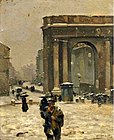.mw-parser-output .hidden-begin{box-sizing:border-box;width:100%;padding:5px;border:none;font-size:95%}.mw-parser-output .hidden-title{font-weight:bold;line-height:1.6;text-align:left}.mw-parser-output .hidden-content{text-align:left}@media all and (max-width:500px){.mw-parser-output .hidden-begin{width:auto!important;clear:none!important;float:none!important))You can help expand this article with text translated from
the corresponding article in French. (April 2019) Click [show] for important translation instructions.
View a machine-translated version of the French article.
Machine translation, like
DeepL or
Google Translate, is a useful starting point for translations, but translators must revise errors as necessary and confirm that the translation is accurate, rather than simply copy-pasting machine-translated text into the English Wikipedia.
Do not translate text that appears unreliable or low-quality. If possible, verify the text with references provided in the foreign-language article.
You must provide
copyright attribution in the
edit summary accompanying your translation by providing an
interlanguage link to the source of your translation. A model attribution edit summary is Content in this edit is translated from the existing French Wikipedia article at [[:fr:Alfred_Smith_(peintre)]]; see its history for attribution.
You may also add the template ((Translated|fr|Alfred_Smith_(peintre))) to the
talk page.
For more guidance, see
Wikipedia:Translation.
Alfred Smith (1854–1932) was a French artist from Bordeaux who painted in the impressionist, post-impressionist and fauvist style.
Some of his works resemble the early works of Claude Monet.[1]
Biography
Smith was born in Bordeaux in 1854 to a father of Welsh origin and a mother from Bordeaux.
He joined a circle of local landscape artists who followed Courbet and Corot.[2]
Smith studied with Hippolyte Pradelles (1876), Léonce Chabry (1880) and Amadeus Baudit (1884).[3]
The distinguished artist Alfred Philippe Roll noticed Smith and helped to promote his work.
He exhibited in the Salon in Paris in 1880, earning an honorable mention.[3]
In 1883 his painting Le quai de Bacalan le soir was exhibited at the Salon.[4]
In the 1880s he became the new leader of the Bordeaux school, displacing Louis Auguin.[2]
However, with no need to earn a living he did not fully devote himself to painting until 1886.[4]
In 1888 he was given a third class medal at the Salon des Artistes français,[5] and in 1889 a bronze medal.
In 1894 he was named a chevalier of the Legion of Honour.
Smith won a bronze medal at the Exposition Universelle in Paris in 1900.[3]
He exhibited regularly at French salons into the 1920s, and many of his works are held in French and Italian museums.[3]
Smith was distinguished for the atmospheric evocation of the woods, gardens and cityscapes, with a subtle and nuanced palette.
He painted scenes from Bordeaux, Paris and Venice before discovering the Creuse valley.[2]
As Smith's style matured he adapted a brighter palette, displayed in his landscapes of the Creuse valley.[3]
He has been called a member of the Crozant School, a broad collection of artists who painted nature around this village of the Creuse valley.[6]
He died in Paris in 1936.[4]
Works
Les Quais de Bordeaux, Le Soir (1892) was exhibited at the Société des Amis des Arts, where it was purchased by the town and is now in the collection of the Musée des Beaux-Arts de Bordeaux. It was hailed as the best painting of the exhibition.[4]
The Musée d'Orsay has three of his works: Sous-Bois (1891), Harmonie d'été (1911) and Portrait de la mère de l'artiste (undated).[7]
The Telfair Museum of Art in Savannah, Georgia owns the 1903 Le déjeuner sous les bois (Luncheon Under the Trees).[8]
Paintings in private collections include:[9]
- 1884 After the rain, oil on canvas
- 1889 Boat Trip, oil on canvas
- 1890 L'aquarelliste, oil on canvas













